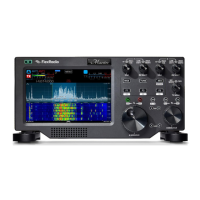FLEX-6000 Signature Series – Maestro User Guide
Copyright 2024 FlexRadio, Inc. All Rights Reserved. | Page 12
4.2.4 USB Power Banks for Maestro “A” and “B”
Maestro “A” and “B” may be powered by a user-supplied 5-volt battery placed in the battery
compartment on the back of the Maestro.
Supplemental batteries used for charging cellular phones and other electronics are plentiful and
relatively inexpensive. The capacity and functionality of these batteries vary across manufacturers
and models. FlexRadio has found that it is not uncommon for the advertised capacities to vary
from actual measured capacities.
Specifications for batteries that are suitable for Maestro:
Maximum size: 6” x 3” x 0.75”
USB-A Female connector for battery drain (5V output)
Minimum output current of 2.1A
Auto-start preferred (will start on load without depressing a button – see below)
Most of these batteries contain an internal Lithium-Ion battery that has a nominal operating
voltage of 3.7V. Typically, the output voltage is produced with a boost regulator that raises the
voltage to 5V DC.
Maestro “A” and “B” are designed to place a load on the battery when it loses power from the wall
charger and most batteries will automatically turn on and begin supplying power in this case
(autostart). If your battery does not supply power when the external supply is removed, Maestro
will display a message indicating that you have two minutes to replace or turn on the battery. If
your battery has an on switch and will not auto start, simply press the on switch and Maestro will
detect the battery voltage, remove the message, and continue normal operation.
For the Maestro “A” and “B” to operate properly, it requires the average voltage from the battery
to be above 4.5V. If the battery voltage falls below 4.25V for an extended period, Maestro will
display the following message:
This message generally indicates one of two possibilities if the battery has been fully charged:
1. The battery has drained beyond its normal capacity and needs to be replaced. Typically,
the battery voltage will be around the 4.25V range and falling. In this case, the battery
should be replaced or charged.
2. There is another issue with the battery, such as a failure, a design issue, or an inability to
provide the necessary power, which requires a replacement of the battery.
If the battery being used cannot supply the required power for Maestro “A” or “B” but does not fall
below 4.25V, it will cause a slow drain of the Maestro “A” and “B” internal battery. If the internal

